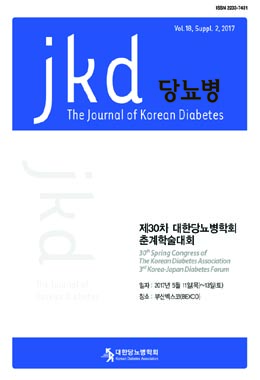Objective: An association between reduced pulmonary function and diabetes has been observed. Our aim was to evaluate the prevalence and risk factors associated with reduced pulmonary function in diabetic patients.
Methods: We analyzed data from the Korea National Health and Nutrition Examination Survey (KNHANES) 2011-2013. The study population included data from 8,784 participants (including 1,431 diabetics) aged ≥ 40 years. Reduced pulmonary function was defined as patients with restrictive (FEV1/FVC ≥ 0.7 and FVC < 80% of predicted value) or obstructive (FEV1/FVC < 0.7) patterns.
Results: Subjects with diabetes had a higher prevalence of restrictive (18.4% vs. 9.4%, P < 0.0001) and obstructive impairments (20% vs. 12.6%, P < 0.0001) than those without diabetes. The adjusted odds ratios (aORs) [95% confidence interval (CI)] for obstructive and restrictive pulmonary impairment were 0.91 (0.75-1.11) and 1.57 (1.30-1.89), respectively. In the diabetes population, age (aOR: 1.04, 95% CI:1.02-1.06), male sex (aOR: 1.40, 95% CI: 1.04-1.88) and body mass index (aOR: 1.15, 95% CI: 1.10-1.21) were independently associated with restrictive pulmonary impairment. Age (aOR: 1.12, 95% CI: 1.09-1.14), male sex (aOR: 4.24, 95% CI: 2.42-7.44), and smoking at any point (ever-smoker; aOR: 1.96, 95% CI: 1.16-3.33) were independent risk factors for obstructive pulmonary impairment in diabetics. Diabetes duration or HbA1c had no association with pulmonary impairment in diabetes.
Conclusion: Subjects with diabetes had a higher risk of restrictive pulmonary impairment than those without diabetes after adjusting for confounding factors. Older age, male sex, body mass index, and smoking were associated with reduced lung function in diabetes.




